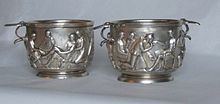Hoby's men's grave
The Iron Age men's grave in Hoby, also known as the chief's grave (in Danish called Høvdingegraven fra Hoby ) on the Danish island of Lolland , was discovered in the Åløkkeskoven (forest) in 1920. The unusually richly decorated body grave dates from the 1st century AD and is one of the richest from the Iron Age in Northern Europe.

The man buried was middle-aged. In addition to objects of local origin, the grave contained an extensive set of drinking and eating utensils of Roman origin (workshop in Capua ). Represent the most significant objects two large silver cup with scenes from the Iliad of Homer . A close second grave found from the period just before the birth of Christ can also be a person assigned by an upscale status.
In the meantime, ceramic finds by an amateur archaeologist have provided evidence of a simultaneous settlement in the immediate vicinity of the burials. Smaller investigations in 2000 and 2001 were followed by a major excavation campaign in 2005, during which the remains of ten houses, some of which were multi-phase, were documented.
See also
literature
- Karsten Kjer Michaelsen: Politics bog om Danmarks oldtid . Copenhagen 2002 ISBN 87-567-6458-8 , p. 214
Individual evidence
- ↑ The approximately two hectare area around the old grave sites was geomagnetically examined in 2010. Drilling carried out in parallel showed archaeological layers of culture in several cases
Web links
- National Museum picture of the exhibition
- Report dan. (PDF; 662 kB)
Coordinates: 54 ° 43 ′ 52.5 ″ N , 11 ° 15 ′ 35.5 ″ E